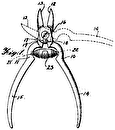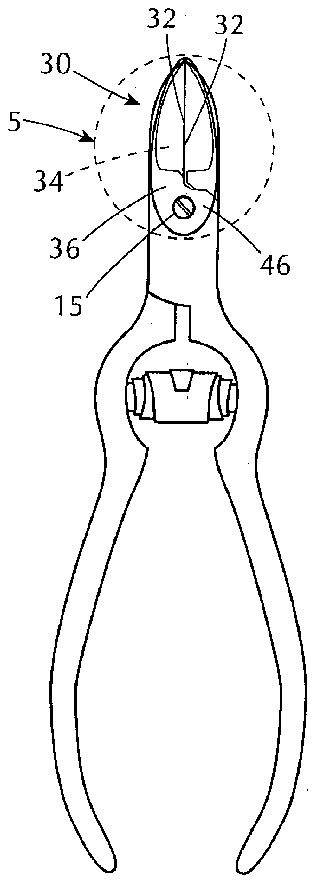
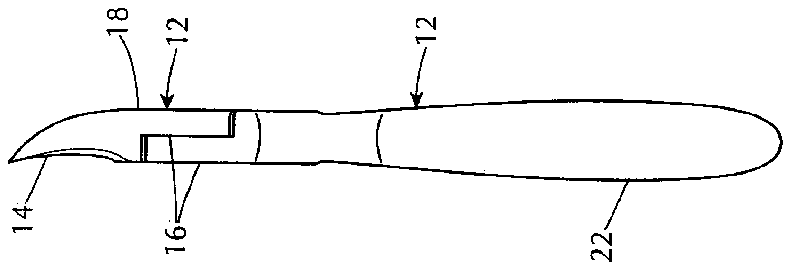
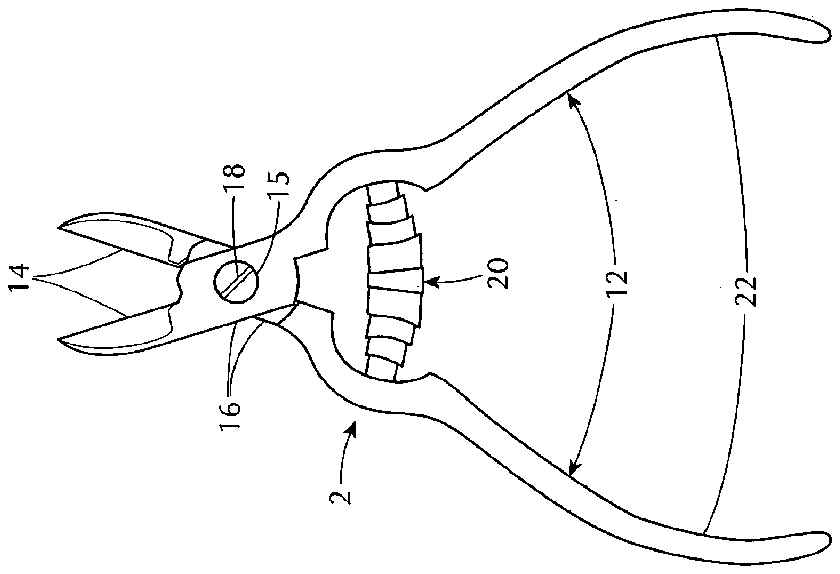

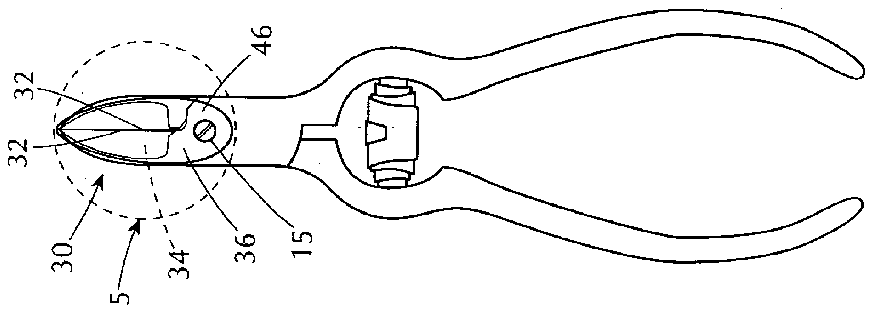
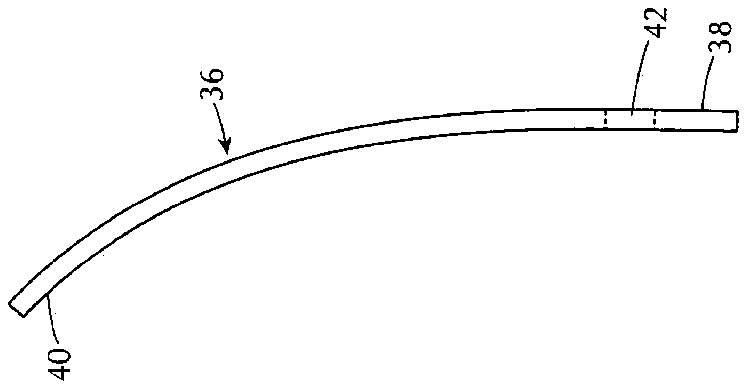
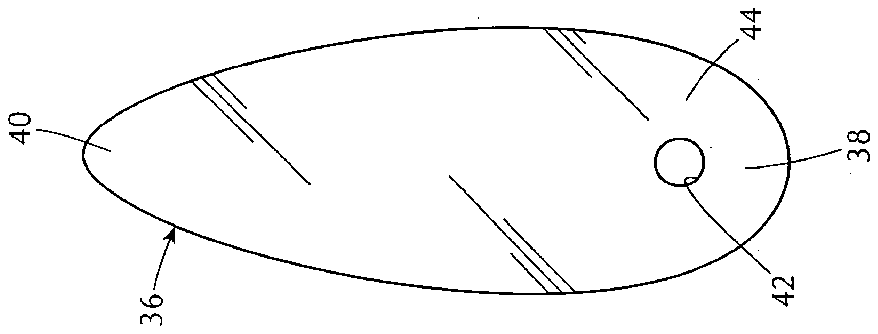
- 2arrow
- 4arrow
- 5arrow
- 6arrow
- 12pivoted members
- 14pivoted members
- 15pivot pin
- 18pivoted lap joint
- 2018 pivoted lap joint
- 22joint 20 spring
- 28subclass
- 30class
- 32cutting jaws
- 34receptacle
- 36catching member
- 38wide end
- 40narrow end
- 42bore
- 44bore
- 46pin
- 186subclass
Abstract
An improved clipper of the type having a pair of pivoted members pivotally attached to each other by a pivot pin and having cutting jaws for cutting nails and being biased away from each other by a spring. The improvement includes a catching member. The catching member is non-rotationally mounted to one of the pair of pivoted members, and together with the cutting jaws, form a receptacle for the nail clippings when the cutting jaws are closed to thereby prevent the nail clippings from scattering.
Description
1. BACKGROUND OF THE INVENTION
[0001] A. Field of the Invention
[0002] The embodiments of the present invention relate to a clipper having cutting jaws for cutting nails and preventing nail clippings formed thereby from scattering, and more particularly, the embodiments of the present invention relate to a clipper having cutting jaws for cutting nails and preventing nail clippings formed thereby from scattering by having the cutting jaws be a part of a receptacle for the nail clippings when the cutting jaws are closed.
[0003] B. Description of the Prior Art
[0004] A particular problem encountered in manicures and pedicures is the resultant creation of errant nail clippings. Such clippings are produced to a great degree when nail clippers are used to trim one's nails because the jaws of the clippers compress the nail when trimming, thus flattening its natural curve. When the nail is trimmed off, it snaps back to its natural shape, thus projecting the clipping into the most unpredictable trajectories or landing places. These nail trimmings could conceivably, for example, lodge in the user's eye with grave consequences, but usually find their way into the pile of a carpet or on a floor not to be found again until some unsuspecting person in bare feet steps on the nail clipping, possibly resulting in injury to the unprotected foot.
[0005] Numerous innovations for nail clippers have been provided in the prior art that will be described below in chronological order to show advancement in the art, and which are incorporated herein by reference thereto. Even though these innovations may be suitable for the specific individual purposes to which they address, however, they differ from the present invention in that they do not teach a clipper having cutting jaws for cutting nails and preventing nail clippings formed thereby from scattering by having the cutting jaws be a part of a receptacle for the nail clippings when the cutting jaws are closed. completely covers the lower jaw with the retainer box, preventing any clippings from being scattered during the clipping process.
[0006] (6) U.S. Pat. No. 5,214,854 to Mennicken.
[0007] U.S. Pat. No. 5,214,854 issued to Mennicken on Jun. 1, 1993 in class 30 and subclass 186 teaches a spring-biased nipper having a pair of handles connected for pivoting movement toward and away from each other. A helical spring has first and second cylindrical ends and a relatively wide central portion tapering toward each end. One end of the spring is threadably received in a bore formed on an inner side of one of the handles. An unthreaded bore on the opposite handle receives the other end of the spring. The spring biases the nipper handles away from one another when a user's grasp on the handles relaxes. In a second embodiment, one end of the spring is glued into the unthreaded bore formed in one of the handles.
[0008] (7) U.S. Pat. No. 6,473,969 to Rinaldi.
[0009] U.S. Pat. No. 6,473,969 issued to Rinaldi on Nov. 5, 2002 in class 30 and subclass 28 teaches a tool for the hygiene and cutting of cuticles, fingernails, and toenails. Two interchangeable jaws are provided with respective cutting blades and are removably supported by two jaw holders connected to respective handles for gripping the tool itself. The jaw holders and the handles are mutually hinged to rotate the aforementioned jaws between an open position and a closed and cutting position.
[0010] (8) Japanese Application Publication Number JP10151280 to Kazuharu et al.
[0011] Japanese Application Publication Number JP10151280 published to Kazuharu et al. on Jun. 9, 1998 in class B26B17 and subclass 00 teaches a tool to prevent chips from scattering when using a cutting pliers, nipper, etc. The tool is provided with cutting tools, a chip-scattering prevention cover, and an attaching mechanism attached to either the cutting tool or the chip-scattering prevention cover for attaching the chip-scattering prevention cover to the cutting tool. The attaching mechanism has at least either a function of attaching/detaching the chip-scattering prevention cover with the cutting tools or a function of changing the cover position relative to the cutting tools to prevent chips cut by the cutting tools from scattering.
[0012] It is apparent that numerous innovations for nail clippers have been provided in the prior art that are adapted to be used. Furthermore, even though these innovations may be suitable for the specific individual purposes to which they address, however, they would not be suitable for the purposes of the embodiments of the present invention as heretofore described, namely, a clipper having cutting jaws for cutting nails and preventing nail clippings formed thereby from scattering by having the cutting jaws be a part of a receptacle for the nail clippings when the cutting jaws are closed.
2. SUMMARY OF THE INVENTION
[0013] Thus, an object of the embodiments of the present invention is to provide a clipper having cutting jaws for cutting nails and preventing nail clippings formed thereby from scattering by having the cutting jaws be a part of a receptacle for the nail clippings when the cutting jaws are closed, which avoids the disadvantages of the prior art.
[0014] Briefly stated, another object of the embodiments of the present invention is to provide an improved clipper of the type having a pair of pivoted members pivotally attached to each other by a pivot pin and having cutting jaws for cutting nails and being biased away from each other by a spring. The improvement includes a catching member. The catching member is non-rotationally mounted to one of the pair of pivoted members, and together with the cutting jaws, form a receptacle for the nail clippings when the cutting jaws are closed to thereby prevent the nail clippings from scattering.
[0015] The novel features considered characteristic of the embodiments of the present invention are set forth in the appended claims. The embodiments of the present invention themselves, however, both as to their construction and their method of operation together with additional objects and advantages thereof will be best understood from the following description of the specific embodiments when read and understood in connection with the accompanying drawing.
3. BRIEF DESCRIPTION OF THE DRAWING
[0016] The figures of the drawing are briefly described as follows:
[0017] FIG. 1 is a diagrammatic front elevational view of prior art nippers;
[0018] FIG. 2 is a diagrammatic side elevational view taken generally in the direction of ARROW 2 in FIG. 1 ;
[0019] FIG. 3 is a diagrammatic front elevational view of the clipper of the embodiments of the present invention having cutting jaws for cutting nails and preventing nail clippings formed thereby from scattering by having the cutting jaws be a part of a receptacle for the nail clippings when the cutting jaws are closed;
[0020] FIG. 4 is a diagrammatic side elevational view taken generally in the direction of ARROW 4 in FIG. 3 ;
[0021] FIG. 5 is an enlarged diagrammatic front elevational view of the area generally enclosed by the dotted curve identified by ARROW 5 in FIG. 3 of the catching member of the embodiments of the present invention; and
[0022] FIG. 6 is a diagrammatic side elevational view taken generally in the direction of ARROW 6 in FIG. 5 .
4. LIST OF REFERENCE NUMERALS UTILIZED IN THE DRAWING
A. Prior art.
[0000]
10 cutting tool
12 pair of pivoted members
14 cutting edge on each of pair of pivoted members 12
15 pivot pin of pivoted lap joint 18
16 pivots of pair of pivoted members 12
18 pivoted lap joint
20 spring
22 handle portions of pair of pivoted members 12 , respectively
B. General.
[0000]
30 clipper of embodiments of present invention having cutting jaws 32 for cutting nails and preventing nail clippings formed thereby from scattering by having cutting jaws 32 be part of receptacle 34 for nail clippings when cutting jaws 32 are closed
32 cutting jaws for cutting nails
34 receptacle for nail clippings when cutting jaws 32 are closed
C. Overall configuration.
36 catching member
D. Specific configuration of catching member 36 .
38 wide end of catching member 36
40 narrow end of catching member 36
42 primary through bore in wide end 38 of catching member 36
44 secondary through bore in wide end 38 of catching member 36
46 pin of one of pair of pivoted members 12
5. DETAILED DESCRIPTION OF THE PREFERRED EMBODIMENTS
A. General.
[0040] Referring now to the figures, in which like numerals indicate like parts, and particularly to FIGS. 3 and 4 , which are, respectively, a diagrammatic front elevational view of the clipper of the embodiments of the present invention having cutting jaws for cutting nails and preventing nail clippings formed thereby from scattering by having the cutting jaws be a part of a receptacle for the nail clippings when the cutting jaws are closed, and a diagrammatic side elevational view taken generally in the direction of ARROW 4 in FIG. 3 , the clipper of the embodiments of the present invention is shown generally at 30 having cutting jaws 32 for cutting nails and preventing nail clippings formed thereby from scattering by having the cutting jaws 32 be a part of a receptacle 34 for the nail clippings when the cutting jaws 32 are closed.
[0000] B. The overall configuration.
[0041] The clipper 30 further has a catching member 36 . The catching member 36 is non-rotationally mounted to one of the pair of pivoted members 12 , and together with the cutting jaws 32 , prevent nail clippings formed thereby from scattering by forming the receptacle 34 for the nail clippings when the cutting jaws 32 are closed.
[0000] C. The specific configuration of the catching member 36 .
[0042] The specific configuration of the catching member 36 can best be seen in FIGS. 5 and 6 , which are, respectively, an enlarged diagrammatic front elevational view of the area generally enclosed by the dotted curve identified by ARROW 5 in FIG. 3 of the catching member of the embodiments of the present invention, and a diagrammatic side elevational view taken generally in the direction of ARROW 6 in FIG. 5 , and as such, will be discussed with reference thereto.
[0043] The catching member 36 is preferably transparent, thin, sheet-like, and teardrop-shaped in plan view to thereby have a wide end 38 and a narrow end 40 .
[0044] The wide end 38 of the catching member 36 is non-rotationally mounted to the one of the pair of pivoted members 12 .
[0045] The narrow end 40 of the catching member 36 follows the planar contour of the cutting jaws 32 and is bent to follow the lateral contour of the cutting jaws 36 , and together with the cutting jaws 32 , prevent nail clippings formed thereby from scattering by forming the receptacle 34 for the nail clippings when the cutting jaws 32 are closed.
[0046] The wide end 38 of the catching member 36 has a primary through bore 42 therethrough. The primary through bore 42 in the wide end 38 of the catching member 36 receives the pivot pin 15 and thereby attaches the catching member 36 to the one of the pair of pivoted members 12 .
[0047] The wide end 38 of the catching member 36 further has a secondary through bore 44 therethrough. The secondary through bore 44 in the wide end 38 of the catching member 36 receives a pin 46 extending from the one of the pair of pivoted members 12 , and together with the pivot pin 15 ( FIG. 1 ), prevent the catching member 36 from rotating relative to the one of the pair of pivoted members 12 when the pair of pivoted members 12 are closed to thereby maintain integrity of the receptacle 34 .
[0000] D. The conclusions.
[0048] It will be understood that each of the elements described above or two or more together may also find a useful application in other types of constructions differing from the types described above.
[0049] While the embodiments of the present invention have been illustrated and described as embodied in a clipper having cutting jaws for cutting nails and preventing nail clippings formed thereby from scattering by having the cutting jaws be a part of a receptacle for the nail clippings when the cutting jaws are closed, however, they are not limited to the details shown, since it will be understood that various omissions, modifications, substitutions, and changes in the forms and details of the embodiments of the present invention illustrated and their operation can be made by those skilled in the art without departing in any way from the spirit of the embodiments of the present invention.
[0050] Without further analysis the foregoing will so fully reveal the gist of the embodiments of the present invention that others can by applying current knowledge readily adapt them for various applications without omitting features that from the standpoint of prior art fairly constitute characteristics of the generic or specific aspects of the embodiments of the present invention.
